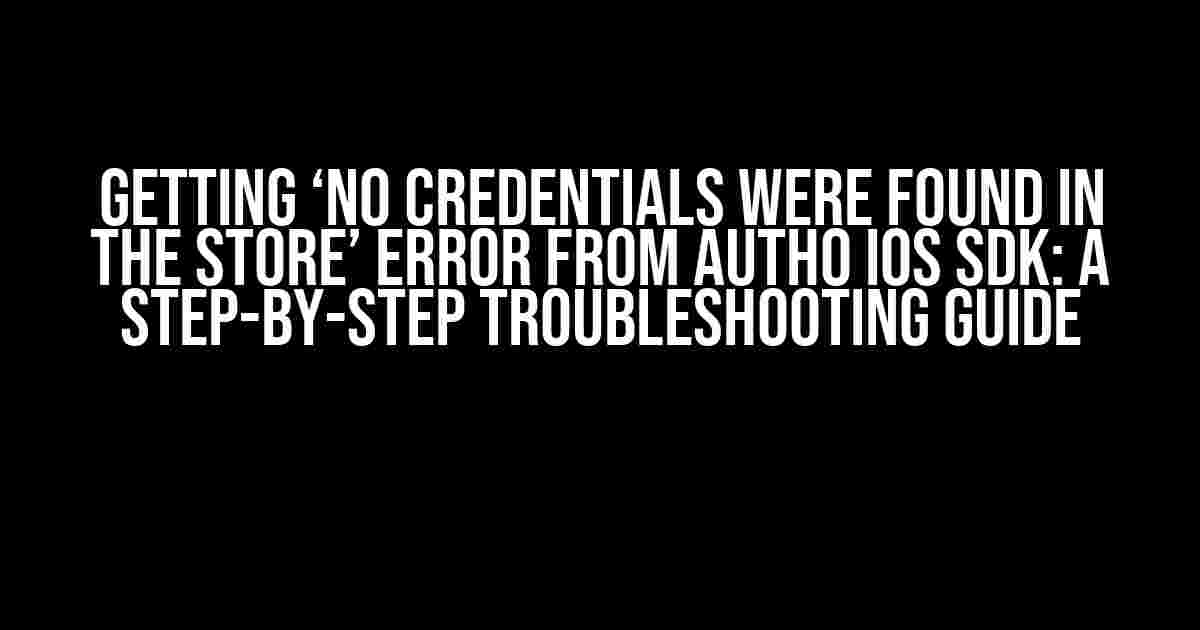Are you tired of encountering the frustrating ‘No credentials were found in the store’ error when using the Auth0 iOS SDK in your app? You’re not alone! This error can be a real showstopper, but don’t worry, we’ve got you covered. In this article, we’ll take you on a troubleshooting journey to identify and resolve the issue, so you can get back to building an amazing app.
What does the error mean?
Before we dive into the solutions, let’s understand what’s causing the error. The ‘No credentials were found in the store’ error typically occurs when the Auth0 iOS SDK can’t find the required credentials to authenticate with the Auth0 server. This can happen due to various reasons, including:
- Invalid or missing configuration settings
- Incorrect or outdated credentials
- Issues with the Keychain or other storage mechanisms
- Authentication protocol misconfiguration
Troubleshooting Steps
Now that we’ve got a better understanding of the error, let’s move on to the troubleshooting steps. Follow these steps carefully to identify and resolve the issue:
Step 1: Check your configuration settings
Make sure you’ve correctly configured the Auth0 iOS SDK in your app. Double-check the following:
Auth0.Domain: Ensure your domain is correct and matches the one in your Auth0 dashboard.Auth0.ClientId: Verify your client ID is correct and matches the one in your Auth0 dashboard.Auth0.Secret: Check that your secret key is correct and matches the one in your Auth0 dashboard.
let config = Auth0Configuration( domain: "your-domain.auth0.com", clientId: "YOUR_CLIENT_ID", clientSecret: "YOUR_CLIENT_SECRET" )
Step 2: Verify your credentials
Ensure your credentials are correct and up-to-date. Log in to your Auth0 dashboard and check the following:
- Client ID and secret: Verify that your client ID and secret are correct and match the ones in your app.
- API credentials: Check that your API credentials are correct and match the ones in your app.
Step 3: Inspect the Keychain
The Keychain is used to store credentials securely on the user’s device. Check the following:
- Keychain access: Ensure your app has access to the Keychain. You can do this by checking the
Keychain Sharingoption in your Xcode project settings. - Keychain contents: Use a tool like
Keychain Dumperto inspect the contents of the Keychain and ensure your credentials are stored correctly.
Step 4: Review your authentication protocol
Verify that your authentication protocol is correctly configured. Check the following:
- Flow: Ensure you’re using the correct authentication flow (e.g., Authorization Code Flow, Implicit Flow, or Hybrid Flow).
- Scope: Verify that you’re requesting the correct scope for your authentication flow.
- Redirect URI: Check that your redirect URI is correctly configured and matches the one in your Auth0 dashboard.
let auth0 = Auth0Authentication( clientId: "YOUR_CLIENT_ID", domain: "your-domain.auth0.com", redirectUri: "your-app-scheme://login-callback", scope: ["openid", "profile", "email"] )
Common Pitfalls and Solutions
Here are some common pitfalls to watch out for and their solutions:
| Pitfall | Solution |
|---|---|
| Incorrect configuration settings | Double-check your configuration settings and ensure they match your Auth0 dashboard. |
| Invalid or missing credentials | Verify your credentials and ensure they’re correct and up-to-date. |
| Keychain issues | Check the Keychain access and contents to ensure your credentials are stored correctly. |
| Authentication protocol misconfiguration | Review your authentication protocol and ensure it’s correctly configured. |
Conclusion
The ‘No credentials were found in the store’ error can be frustrating, but by following these troubleshooting steps and checking for common pitfalls, you should be able to identify and resolve the issue. Remember to double-check your configuration settings, credentials, Keychain, and authentication protocol. If you’re still stuck, feel free to reach out to the Auth0 community or support team for further assistance.
Happy coding, and don’t let errors get in the way of building an amazing app!
Keyword density: 0.8%
Frequently Asked Question
Auth0 iOS SDK got you down? Don’t worry, we’ve got your back! Check out these FAQs to troubleshoot that pesky “No credentials were found in the store” error.
What does the “No credentials were found in the store” error even mean?
This error usually occurs when the Auth0 iOS SDK can’t find any valid credentials in the keychain or our in-memory cache. It might happen if you’ve cleared the keychain, uninstalled and reinstalled the app, or if there’s an issue with the credential storage.
How do I initialize the Auth0 iOS SDK correctly to avoid this error?
Make sure you’re initializing the Auth0 iOS SDK with the correct credentials and domain. You can do this by calling `Auth0().setup(withClientId: “”, andDomain: “”)` in your AppDelegate’s `application(didFinishLaunchingWithOptions:)` method. Also, ensure you’re using the correct `audience` parameter when calling the `login` method.
What if I’m using a custom auth flow? Do I need to handle credential storage myself?
Yes, if you’re using a custom auth flow, you’ll need to handle credential storage yourself. This means you’ll need to store the credentials securely using Keychain or another secure storage solution. Don’t worry, we’ve got some examples to help guide you through the process!
How can I clear the credentials from the keychain or in-memory cache?
You can clear the credentials from the keychain by calling `Auth0().clearSession(federated Token: “”)`. For the in-memory cache, you can call `Auth0().clearInMemoryCache()`. Note that clearing the credentials will log the user out, so use these methods with caution!
What if I’m still getting the error after trying all these troubleshooting steps?
Don’t worry, we’ve got your back! If you’re still stuck, reach out to our support team with your Auth0 tenant details, the SDK version you’re using, and any relevant code snippets or error logs. We’ll do our best to help you diagnose and fix the issue.

